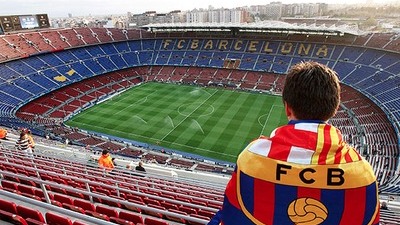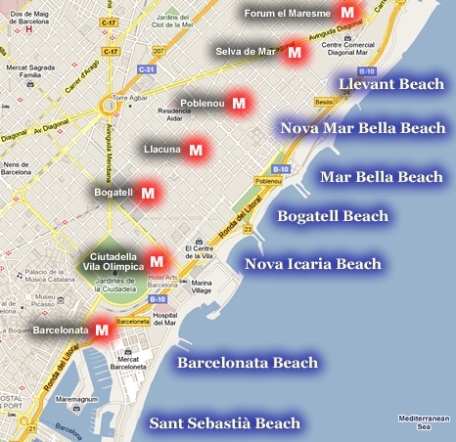1 – “La Rambla” Street :
“La Rambla is a street in central Barcelona, popular with tourists and locals alike. A tree-lined pedestrian mall, it stretches for 1.2 kilometres (0.75 mi) connecting Plaça de Catalunya in the centre with the Christopher Columbus Monument at Port Vell. La Rambla forms the boundary between the quarters of Barri Gòtic, to the east, and El Raval, to the west.
La Rambla can be crowded, especially during the height of the tourist season. Its popularity with tourists has affected the character of the street, with a move to pavement cafes and souvenir kiosks. It has also suffered from the attention of pickpockets and, especially towards its southern end, sex workers.
The Spanish poet Federico García Lorca once said that La Rambla was “the only street in the world which I wish would never end.” “
http://en.wikipedia.org/wiki/La_Rambla,_Barcelona
FREE
2 – Barrio Gotico area of Barcelona
“The Gothic Quarter is the centre of the old city of Barcelona. It stretches from La Rambla to Via Laietana, and from the Mediterranean seafront to Ronda de Sant Pere. It is a part of Ciutat Vella district.
Despite several changes undergone in the 19th and early 20th century, many of the buildings date from Medieval times, some from as far back as the Roman settlement of Barcelona. Remains of the squared Roman Wall can be seen around Tapineria and Sots-Tinent Navarro to the north, Avinguda de la Catedral and Plaça Nova to the west and Carrer de la Palla to the south. El Call, the medieval Jewish quarter, is located within this area too.
The Barri Gòtic retains a labyrinthine street plan, with many small streets opening out into squares. Most of the quarter is closed to regular traffic although open to service vehicles and taxis.“
http://en.wikipedia.org/wiki/Gothic_Quarter,_Barcelona
FREE
3 – Gaudí: La Sagrada Familia church
Top Ten tourist attractions Barcelona
“The Basílica i Temple Expiatori de la Sagrada Família is a large Roman Catholic church in Barcelona,Spain, designed by Catalan architect Antoni Gaudí (1852–1926). Although incomplete, the church is a UNESCO World Heritage Site, and in November 2010 Pope Benedict XVI consecrated and proclaimed it a minor basilica, as distinct from a cathedral which must be the seat of a bishop.
Construction of Sagrada Família had commenced in 1882 and Gaudí became involved in 1883, taking over the project and transforming it with his architectural and engineering style, combining Gothic and curvilinear Art Nouveau forms. Gaudí devoted his last years to the project, and at the time of his death at age 73 in 1926 less than a quarter of the project was complete…”
http://en.wikipedia.org/wiki/Sagrada_familia
4 – Gaudí: Modernist Park Guell
It can be reached by underground railway (although the stations are at a distance from the Park and at a much lower level below the hill), by city buses, or by commercial tourist buses. From October 2013 the entrance to the Park is free but there is an entrance fee to visit the monumental zone (main entrance and the parts containing mosaics). Gaudí’s house, “la Torre Rosa,” — containing furniture that he designed — can be only visited for an another entrance fee. There is a reduced rate for those wishing to see both Gaudí’s house and the Sagrada Família Church.
Park Güell is skillfully designed and composed to bring the peace and calm that one would expect from a park. The buildings flanking the entrance, though very original and remarkable with fantastically shaped roofs with unusual pinnacles, fit in well with the use of the park as pleasure gardens and seem relatively inconspicuous in the landscape when one considers the flamboyance of other buildings designed by Gaudí. One of these buildings houses a permanent exhibition of the Barcelona City History Museum MUHBA focused on the building itself, the park and the city.
The focal point of the park is the main terrace, surrounded by a long bench in the form of a sea serpent. The curves of the serpent bench form a number of enclaves, creating a more social atmosphere. Gaudí incorporated many motifs of Catalan nationalism, and elements from religious mysticism and ancient poetry, into the Park.
http://en.wikipedia.org/wiki/Park_G%C3%BCell
5 – Modernist buildings
Casa Mila :
http://en.wikipedia.org/wiki/Casa_Mil%C3%A0
Casa Batlló :
http://en.wikipedia.org/wiki/Casa_Batll%C3%B3
Palau de la Música Catalana :
http://en.wikipedia.org/wiki/Palau_de_la_M%C3%BAsica_Catalana
Hospital de Sant Pau, Barcelona :
http://en.wikipedia.org/wiki/Hospital_de_Sant_Pau
…
6 – Tibidabo hill
Tibidabo is a mountain overlooking Barcelona, Catalonia, Spain. At 512 meters it is the tallest mountain in the Serra de Collserola. Rising sharply to the north-west, it affords spectacular views over the city and the surrounding coastline.
There is an amusement park, a telecommunications tower (Torre de Collserola), and a Catholic church, the Temple de Sagrat Cor, at the top, all of which are visible from most of the city. Designed by Enric Sagnier, the church took 60 years to construct and is topped by a sculpture of the Sacred Heart of Jesus by Josep Miret Llopart.
The amusement park is the oldest in Barcelona and still has most of the original rides, some of which date to the turn of the 20th century. The park was featured in the Woody Allen film, Vicky Cristina Barcelona.
Tibidabo can be reached by funicular railway, bus, bicycle, or car. The railway, built in 1901, was the first of its kind in Spain.
http://en.wikipedia.org/wiki/Tibidabo
7 – Magic Fountain show
The Magic Fountain of Montjuïc is a fountain located at the head of Avenida Maria Cristina in the Montjuïc neighborhood of Barcelona, Catalonia,Spain. The fountain is situated below the Palau Nacional on the Montjuïc hill and near the Plaça d’Espanya and Poble Espanyol de Barcelona. The fountain, like most of the surrounding developments, was constructed for the1929 Barcelona International Exposition.
http://en.wikipedia.org/wiki/Magic_Fountain_of_Montju%C3%AFc
8 – Museums Barcelona
- Picasso
- MACBA
- …
9 – FC Barcelona museum & Camp Nou stadium
…
10 – Montjuic hill and Poble Espanyol Spanish villag
…







